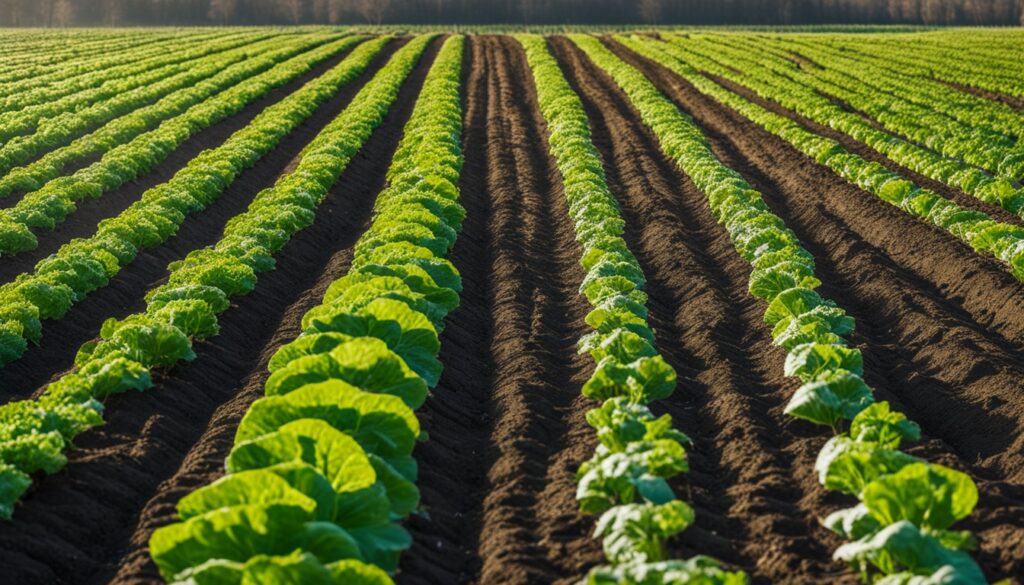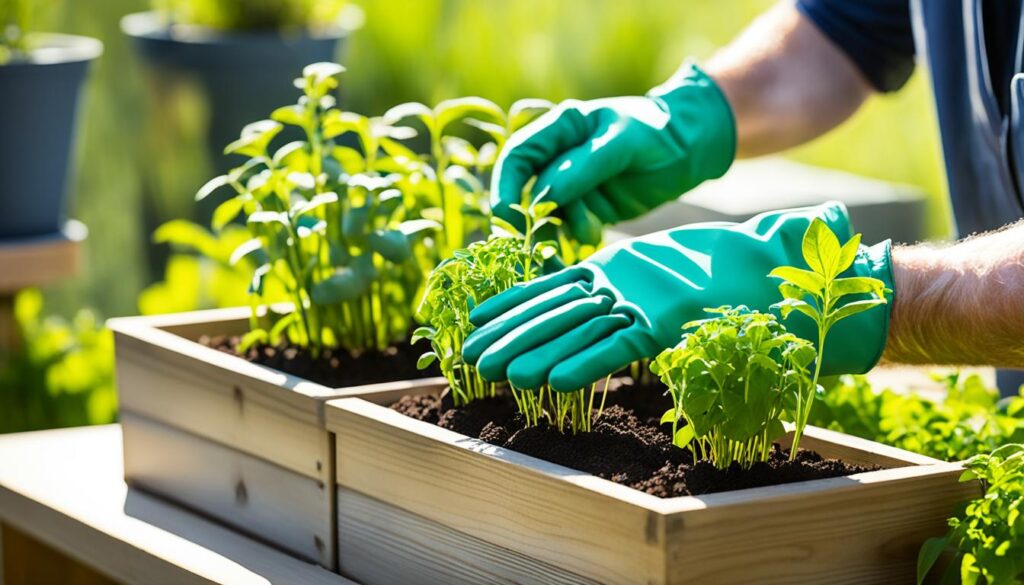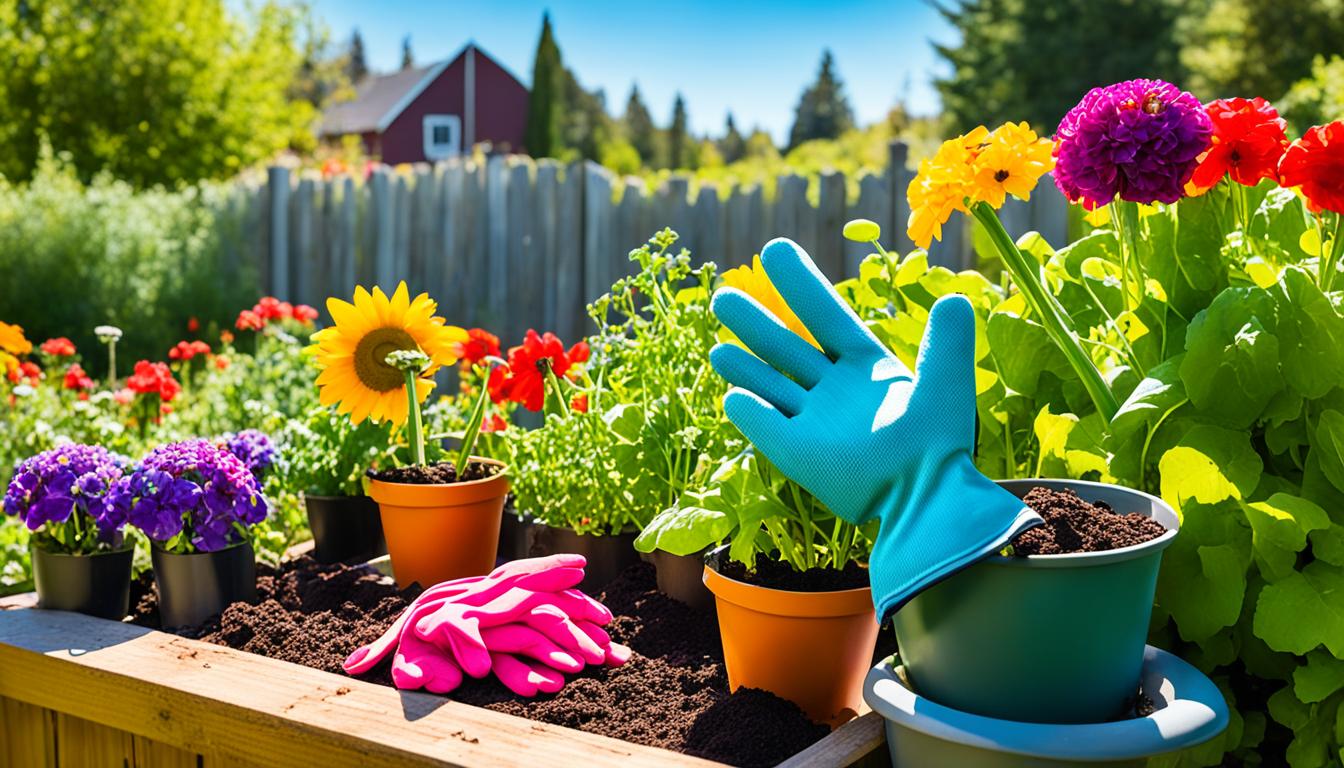This post contains affiliate links.
As the sun breaks through the winter clouds, I feel the earth waking up. Gardening is more than a hobby; it’s a dance with nature. It’s a symphony of seasons, bringing joy to my body and soul. Watching your hard work turn into vibrant blooms and a bountiful harvest is unmatched.
We’ll take a month-by-month journey through the gardening year. We’ll explore the unique rhythms and needs of each season. From winter planning to summer’s peak and fall’s gentle end, I’ll share tips and wisdom. Let’s get ready to bring out the best in every seed, bulb, and transplant. With the right timing and care, your garden can be extraordinary.
Key Takeaways
- Timing is everything in vegetable gardening, and following a month-by-month to-do list can make all the difference.
- Consult your local cooperative extension for a customized gardening calendar that accounts for your region’s unique climate and growing conditions.
- Start planning your garden early by creating a map and ordering seeds, ensuring you have the supplies and tools needed for a successful growing season.
- Consider starting seeds indoors to get a head start on the season, then carefully transition them to the outdoor garden when the time is right.
- Embrace the changing seasons by planting a diverse array of cool-weather and heat-loving crops for a bountiful, year-round harvest.
The Importance of Timing in Gardening
Timing is crucial in gardening. Knowing about Seasonal Gardening and Garden Planning can greatly affect your harvest. The USDA Plant Hardiness Zones divide North America into 13 climate regions.
Understanding Plant Hardiness Zones
Each USDA Plant Hardiness Zone shows a 10-degree Fahrenheit difference in winter temperatures. This means planting and growing seasons change a lot by location. What works in one zone might not work in another.
Localizing Your Garden Calendar
To time your Seasonal Gardening right, use a Planting Calendar for your area. Your local county cooperative extension office can give you the best times for seeding, transplanting, and harvesting. By matching your garden with your local climate, you’ll boost your Garden Planning success.
“The more preparation you do in advance, the better your plants will fare in the garden.”
For a successful garden, understand your region’s growing conditions and plan accordingly. Embracing timing is key to a great Seasonal Gardening experience.
January: Planning and Preparation
As the new year begins, it’s time to plan and prepare for the garden season ahead. In January, focus on making a detailed Garden Planning and Seed Ordering strategy. This will help set your garden up for success.
Creating a Garden Map and Seed Order
Start by drawing a Garden Map of your growing area. Note the layout of your beds and what worked or didn’t last year. This helps you decide on crop rotation and where to plant things.
Then, order your seeds early, as popular ones can quickly run out. Look for heirloom, organic, and locally-adapted seeds for a great harvest.
Gathering Gardening Supplies and Tools
Collect all the Gardening Supplies and Gardening Tools you need for the season. Make sure you have seed trays, growing mix, a garden thermometer, and various hand tools. Clean and sharpen any tools you already have to make sure they’re ready for action.
| Gardening Supplies | Gardening Tools |
|---|---|
| Seed trays | Hand trowel |
| Growing mix | Garden fork |
| Garden thermometer | Pruning shears |
| Plant labels | Hoe |
By planning and preparing in January, you’re setting the stage for a successful and fruitful Garden in the coming seasons.

February: Starting Seeds Indoors
As winter hangs on, gardeners are getting ready for spring. Starting seeds indoors in February is key. It gives your plants a jumpstart and lets you grow a variety of plants not found in nurseries.
Organizing Seeds for Germination
First, organize your seeds. Group them by when they should be planted, counting back from the last frost. This way, you plant each seed at the best time for growth.
- Find out when the last frost is in your area, usually early April in Alexandria, VA, and late April in Lothian, MD.
- Work out when to start seeds, about 6-8 weeks before the last frost.
- Put your seeds in order, starting heat lovers like tomatoes and peppers in early February. Cool crops like lettuce and carrots go in later.
Preparing Seed Starting Supplies
Have everything you need for seed starting. You’ll need seed trays, good seed starting mix, and containers like peat pots. Don’t use regular garden soil to avoid pests and diseases.
With your seeds and supplies ready, you’re set for a successful garden. The effort now means a great harvest later.
March: Soil Preparation and Cool-Season Crops
March is the ideal time to prepare your soil and plant cool-season crops as days get longer and temperatures rise. This step is crucial for a successful garden all year.
Testing and Amending Soil
Testing your soil’s pH is key before planting. The right pH level affects how well plants get nutrients. Aim for a pH between 6.0 and 7.0 for best growth. If your soil is off balance, add organic stuff like compost or manure to fix it.
With your soil ready, plant cool-season crops like broccoli, cabbage, kale, lettuce, spinach, and onions. These veggies do well in cooler weather and can handle a bit of frost. This lets you start your garden early.
Planting Cool-Season Vegetable Seeds
Pay attention to soil temperature when planting cool-season crops. They like soil between 55°F and 75°F. If it’s too cold, start seeds indoors and move them outside when it’s better. Watch the weather and protect your plants from frost.

Preparing your soil and planting cool-season crops in March sets you up for a great garden all year. Keep an eye out and try new things to see what works best for your garden.
April: Transitioning to Warm-Season Crops
As the weather gets warmer in Hendersonville, Tennessee, it’s time to switch your garden to warm-season vegetables. This change is key for a successful garden all season long.
Monitoring Soil Temperature
Before planting warm-season crops, check your soil temperature. Wait for it to be at least 60°F before planting tomatoes, peppers, eggplant, and squash. This makes sure they grow well.
Transplanting Seedlings Outdoors
If you didn’t start seeds indoors, buy transplants now. Put them in your garden carefully to prevent shock. Loosen the roots, plant them the same depth as before, and water well to help them settle.
Switching to warm-season gardening means watching your soil temperature, caring for your plants, and keeping up with watering and feeding. With attention and the right timing, your garden will be full of Warm-Season Crops soon.
“Timing is everything in the garden, and paying close attention to soil temperature is crucial for a successful transition to warm-season crops.”
May: The Busy Planting Month
As temperatures rise and soil warms up, May is the perfect time for gardeners to plant warm-season crops. This month is ideal for planting vegetables and flowers that love the summer heat.
Planting Heat-Loving Crops
When soil hits 70°F consistently, it’s time to plant tomatoes, peppers, and eggplant. These Warm-Season Crops love the long days and plenty of sun. They will give you a great harvest all summer.
Direct Sowing Warm-Season Seeds
May is great for Direct Sowing warm-season seeds directly in the garden. Seeds like carrots, beets, and radishes do well this way. They get to grow strong roots and develop naturally.
Watch your seeds closely and thin them out as they grow. This lets each plant get enough space to grow well. With the right timing and care, your garden will soon be full of color and tasty produce.
| Warm-Season Crops | Planting Recommendations |
|---|---|
| Tomatoes | Plant transplants once soil reaches 70°F or above |
| Peppers | Plant transplants once soil reaches 70°F or above |
| Eggplant | Plant transplants once soil reaches 70°F or above |
| Carrots | Direct sow seeds in the garden |
| Beets | Direct sow seeds in the garden |
| Radishes | Direct sow seeds in the garden |
“May is a busy month in the garden, but the rewards of planting heat-loving crops and directly sowing warm-season seeds are well worth the effort. With a little care and attention, your garden will be thriving in no time.”
June: Maintenance and Early Harvests
June brings your garden to life, making it time to focus on maintenance and harvesting. With the right care, your plants will thrive and give you a great harvest. This is a key time to keep your garden in top shape.
Staking and Supporting Plants
As plants like tomatoes and cucumbers grow tall, they need support. Proper staking keeps them upright and makes picking easier. Use strong stakes, cages, or trellises to help your plants grow well.
Harvesting Cool-Season Crops
Don’t miss out on your cool-season crops! Watch your greens, peas, and beans closely. Harvest them in the cool part of the day to keep them healthy. Lettuce varieties can be sown throughout the season for multiple harvests in June, giving you fresh greens all season.
Regular weeding is key, spending a few minutes a few times a week. Watering roots in the early morning and adding mid-season fertilizer are important tips for June gardening.
“The Spring Into Summer Mix contains 49 heat-tolerant species for June planting, while the specially formulated Spring Into Summer Wildflower Seed Mix designed for June planting contains over 40 species, primarily annual wildflowers that bloom just weeks after planting and last well into the fall.”
June gardening varies by region. Adjust your gardening based on your local climate for the best results. This can help your garden thrive and produce well.

June is full of life and energy, so dive into staking, supporting, and harvesting your plants. With a bit of care, your garden will give you plenty of fresh, tasty produce all summer.
July: Peak Growing Season
Summer is here, and your garden is in full swing. Now, it’s time to keep it productive. Use strategies to make your harvest last longer and help your plants do well in the heat.
Extending the Harvest
Use Continuous Harvest to keep your garden full of fresh food all season. Plant seeds of the same crop often to get a steady supply. This way, you won’t have too much food at once.
Plant flowers like zinnias, cosmos, and marigolds by July 4th for a late bloom. Cut back chrysanthemums by then to make them grow shorter and produce more flowers in the fall.
Consistent Watering and Weeding
Watering and Weeding are key in the hot summer. Plants need regular water to stay healthy. Not watering enough can cause problems like blossom-end rot in tomatoes and peppers.
Keep your garden weed-free to stop them from taking over. Regular care makes your garden look great and helps your plants grow well.
| Task | Frequency | Purpose |
|---|---|---|
| Fertilize annual flowers | Every 2 weeks | Maintain appearance and health |
| Prune and dispose of old fruiting canes on raspberries and blackberries | After harvest | Support new growth |
| Fertilize rhubarb and asparagus plantings | July | Promote growth |
| Limit nitrogen fertilization for cool-season lawns | 0.5 lb N per 1000 sq ft | Prevent excessive growth |
| Fertilize Zoysiagrass lawns | 0.5 lb N per 1000 sq ft, mow at 1-2 inches weekly | Maintain healthy, compact growth |
Embrace the peak growing season to make your Continuous Harvest last longer. Keep your garden healthy with regular Watering and Weeding.
From Seed to Bloom: A Month-by-Month Guide to Gardening
As you go through the gardening year, using succession planting and being ready to fix common garden problems can make your garden thrive. It helps you grow a garden that’s full of life from seed to bloom.
Succession Planting for Continuous Harvest
Succession planting is a smart way to make your garden work harder and give you fresh produce all season. By planting certain crops at different times, you can keep getting new harvests. For instance, plant lettuce, radishes, or beans every 2-3 weeks instead of all at once.
- Rotate vegetable families to reduce disease buildup.
- Try starting vegetables indoors from seed to get a jump start on the growing season.
- Plant seeds of cool-season vegetables (peas, lettuce, spinach, radishes) as soon as garden soil is workable.
- Plant warm-season vegetables and annual flowers once the threat of the last frost has passed.
Troubleshooting Common Garden Issues
Gardens have their challenges, like pests, diseases, and environmental issues. By tackling problems early, you can keep your garden healthy and full of life. Check out the “The Best Plants for 30 Tough Sites” guide for tips from Master Gardeners on solving common garden problems.
| Issue | Recommended Solutions |
|---|---|
| Deicing salt damage | Use salt-tolerant plants, apply mulch, and consider hiring tree care professionals. |
| Plant diseases | Implement preventative measures, such as rotating crop families and using companion planting. |
| Pests | Utilize chemical and non-chemical methods, including promoting beneficial insects. |
By paying attention to your plants’ needs and adjusting your gardening, you can enjoy a full harvest from seed to bloom.
September: Preparing for Fall
As summer ends and autumn begins, it’s time to get your garden ready for the new season. September is key for planting crops that do well in the fall and winter. This is crucial for a successful garden.
Planting Cool-Weather Crops
September’s cool temperatures and plenty of rain are perfect for starting your fall garden. Great crops to plant now include:
- Lettuce
- Spinach
- Broccoli
- Kale
- Radishes
- Carrots
These veggies love the cooler weather and will keep you eating well into the cold months. Make sure to pick varieties right for your Fall Gardening area. Plant them correctly for the best growth.
Removing Spent Plants
Clearing out old plants makes room for new ones. It also stops diseases and pests from spreading. Remove any plants that are done for the season. Compost them and prepare your garden for new plants.
Preparing your garden in September sets you up for a great Fall Gardening season.
October: Wrapping Up the Season
October brings the end of the growing season as summer’s warmth fades into crisp autumn air. It’s time to gather your warm-season crops and get your garden ready for winter.
Harvesting Warm-Season Crops
Harvest any left tomatoes, peppers, squash, and other warm-weather veggies with care. Make sure to store them well to enjoy their flavors before winter comes.
Preparing for Winter
End the growing season by protecting your garden for winter. Remove dead plants and debris to keep pests away. Mulch around perennials to keep their roots warm and stop weeds.
- Protect crops like garlic and asparagus with lots of mulch.
- Clean and store garden tools for the next season.
- Plant cover crops or spread compost to enrich the soil for next year.
By harvesting, cleaning, and preparing your garden in October, you’re ready for a great growing season next year.
“Autumn is a second spring when every leaf is a flower.” – Albert Camus
Conclusion
Using a month-by-month gardening guide can make your garden thrive all year. It teaches you about timing, succession planting, and solving garden problems. This guide is great for both new and experienced gardeners. It gives you the tools and knowledge to make a garden that brings joy and food for many seasons.
This guide starts with planning your garden and ordering seeds in January and ends in October. It shows you how to plant at the right time using nature’s signs like flowers blooming and seasons changing. This way, you can make the most out of your garden.
With the right methods and patience, you can grow a beautiful, productive garden. It will make you happy and feed you well. So, get ready to work hard, get your hands dirty, and see your garden grow from seed to bloom.
FAQ
When is the best time to start planning and preparing for the upcoming growing season?
When should I start seeds indoors for the upcoming season?
When should I start planting my cool-season crops?
When can I start planting my warm-season crops?
What tasks should I focus on in May?
What should I focus on in the garden during the peak of the growing season in July?
How can I prepare my garden for the cooler months ahead?
What should I do to wrap up the gardening season in October?
Source Links
- Master Your Garden Month-By-Month – https://cesantabarbara.ucanr.edu/Master_Gardener/Resources/Master_Your_Garden_Month-By-Month/
- How does my garden grow? – https://ask.metafilter.com/262768/How-does-my-garden-grow
- What To Plant Now: A Monthly Guide For Your Vegetable Garden – The Tiny Life – https://thetinylife.com/month-by-month-vegetable-gardening-guide/
- When to Start Planting Vegetables in Your Garden, a Month-by-Month Guide – https://www.realsimple.com/home-organizing/gardening/outdoor/month-by-month-vegetable-gardening-guide
- A How-To Guide to Gardening by the Moon – https://www.almanac.com/content/planting-by-the-moon
- Extension | Seed Starting – https://extension.wvu.edu/lawn-gardening-pests/gardening/gardening-101/seed-starting
- The Ultimate Guide to January Gardening in South Florida – https://livingcolorgardencenter.net/gardening/a-guide-to-january-gardening-in-south-florida/
- Zone 4 – Monthly Garden Calendar: Chores and Planting Guide – https://sowtrueseed.com/blogs/monthly-garden-schedule-by-zone/zone-4-monthly-garden-calendar-chores-and-planting-guide
- Gardening in January: A Fresh Start to a Flourishing Garden – https://als-gardencenter.com/blogs/tips-and-inspiration/gardening-in-january-a-fresh-start-to-a-flourishing-garden
- Vegetable Seeds to Start in February | Greenstreet Gardens – https://greenstreetgardens.com/vegetable-seeds-to-start-in-february/
- Starting Seeds Indoors: How and When to Start Seeds – https://www.almanac.com/content/starting-seeds-indoors
- Seed Starting Essentials | Basics of Germination | joegardener® – https://joegardener.com/podcast/seed-starting-essentials/
- Time of planting – https://mg.ucanr.edu/Gardening/Vegetable/Preparing/PlantingTime/
- March garden calendar – https://extension.oregonstate.edu/gardening/techniques/march-garden-calendar
- Your Alameda County Garden, Month-by-Month – https://acmg.ucanr.edu/Your_Garden_Month-by-Month/
- Double your veggies: There’s a bounty in the garden as warm- and cool-season types overlap – https://www.nola.com/entertainment_life/home_garden/warm–and-cool-season-veggies-overlap-for-a-garden-bounty/article_da24965a-3301-11ee-b0c8-53b857350d20.html
- A Simple Guide To Gardening Month By Month – Follow The Yellow Brick Home – https://followtheyellowbrickhome.com/simple-guide-gardening-month-by-month/
- May Gardening Checklist – https://www.rogersgardens.com/blogs/current-news-events/may-gardening-checklist
- Monthly Garden Calendars – https://extension.oregonstate.edu/collection/monthly-garden-calendars
- June Gardening: What To Plant – https://www.americanmeadows.com/content/june-gardening-what-to-plant
- June Garden Guide: Planning, Planting, and More – https://www.tenthacrefarm.com/plant-june/
- Summer Gardening: June Garden Checklist Zones 6-8 – https://kellogggarden.com/blog/gardening/june-garden-checklist-zones-6-8/
- July Gardening Tips (Donna Aufdenberg) – https://ipm.missouri.edu/meg/2024/6/July_Gardening_Tips/
- Vegetables and Herbs You Can Plant in July by Hardiness Zone – https://www.thespruce.com/planting-vegetables-and-herbs-in-july-2540000
- Planting and growing guides – https://extension.umn.edu/how/planting-and-growing-guides
- Gardener’s Almanac Monthly Gardening Checklist – https://extension.usu.edu/yardandgarden/monthly-tips
- Perennials Monthly Bloom Calendar | Petitti Garden Centers – https://www.petittigardencenter.com/perennials-monthly-bloom-calendar/
- Zone 7 – Monthly Garden Calendar: Chores and Planting Guide – https://sowtrueseed.com/blogs/monthly-garden-schedule-by-zone/zone-7-monthly-garden-calendar-chores-and-planting-guide
- Zone 6 – Monthly Garden Calendar: Chores and Planting Guide – https://sowtrueseed.com/blogs/monthly-garden-schedule-by-zone/zone-6-monthly-garden-calendar-chores-and-planting-guide
- October Planting Zone-by-Zone – https://harvesttotable.com/october-tips-from-harvesttotable-com/
- Fall Gardening: October Garden Checklist Zones 4-5 – https://kellogggarden.com/blog/gardening/october-garden-checklist-zones-4-5/
- National Gardening Month: Time to clean your garden – or start one – AgriLife Today – https://agrilifetoday.tamu.edu/2024/04/04/national-gardening-month-time-to-clean-your-garden-or-start-one/
- Planting by Phenology (Natural Plant and Animal Cycles) (gardening for beginners forum at permies) – https://permies.com/t/phenology
- Growing Schedule — the kokoro garden – https://thekokorogarden.com/growing-schedule
This post contains affiliate links.

